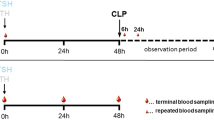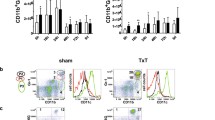Summary
Bone fracture, soft-tissue trauma and hemorrhagic shock are frequent complications in trauma patients, and these patients are known to be immunocompromised. Nonetheless, it is difficult to differentiate the effect of soft-tissue trauma plus hemorrhage from that of bone fracture and hemorrhage on host immune function in the clinical setting. To determine this experimentally, closed bone fracture (right lower leg) and/or soft-tissue trauma (2.5 cm midline laparotomy) were induced prior to hemorrhagic shock (mean arterial BP of 35 ± 5 mm Hg for 90 min) in male C3H/HeN mice. All animals were killed at 72 h after initiation of the experiment and the spleens were collected aseptically. More significant depression of splenocyte IL-2 and IL-3 release occurred with the combined insult than after bony injury or tissue trauma alone with hemorrhage. The present study suggests that different traumatic insults, i. e. bone fracture as well as soft-tissue trauma in conjunction with hemorrhagic shock, produce comparable depression of host immune function. Moreover, combination of closed bone fracture and soft-tissue trauma prior to hemorrhagic shock leads to even more compromised immunity. This indicates that different mechanisms of immune depression may be involved following soft-tissue trauma or bony injury coupled with hemorrhage. The markedly depressed immune function following bony injury, soft-tissue trauma and hemorrhagic shock may contribute to the increased susceptibility of severely injured patients to sepsis and the ensuing multiple organ failure in the clinical situation.
Zusammenfassung
Knochenbruch, Weichteiltrauma und hämorrhagischer Schock sind häufige Komplikationen bei polytraumatisierten Patienten. In klinischen Studien ist es nicht möglich, den Beitrag von Weichteiltrauma und Knochenfraktur zur bekannten Immundepression nach hämorrhagischem Schock isoliert zu untersuchen. Bei männlichen C3H/HeN-Mäusen wurde hämorrhagischer Schock (35 ± 5 mm Hg für 90 min) in Kombination mit Weichteiltrauma (2,5-cm-Mittellinienlaparotomie) und/oder geschlossener Tibiafraktur (rechter Unterschenkel) induziert, 72 h nach diesem Experiment wurden alle Tiere getötet, die Milz steril entnommen, suspendiert und eine Zellkultur angelegt, um die Produktion von Interleukin (IL)-2 und IL-3 in spezifischen Bioassays zu bestimmen. Unsere Ergebnisse zeigen, daß Weichteiltrauma in Kombination mit hämorrhagischem Schock sowie Knochenfraktur in Kombination mit hämorrhagischem Schock zu einer vergleichbaren Immundepression führen, während Weichteiltrauma, Knochenfraktur und hämorrhagischer Schock in noch verstärkter Immundepression resultieren. Unsere Ergebnisse erlauben somit, auf unterschiedliche Pathomechanismen für die Immundysfunktion nach Weichteiltrauma oder Knochenverletzung in Verbindung mit hämorrhagischem Schock zu schließen. Die im Tierexperiment gezeigte signifikante Immundysfunktion nach Mehrfachverletzung (Weichteiltrauma, Knochenfraktur plus Schock) kann zu der erhöhten Sepsisanfälligkeit und dem resultierenden Risiko für multiples Organversagen polytraumatisierter Patienten beitragen.
Similar content being viewed by others
Author information
Authors and Affiliations
Rights and permissions
About this article
Cite this article
Wichmann, M., Remmers, D., Ayala, A. et al. The contribution of soft-tissue trauma and/or bone fracture to depressed immunity following hemorrhagic shock in an experimental setting. Unfallchirurg 101, 37–41 (1998). https://doi.org/10.1007/s001130050230
Published:
Issue Date:
DOI: https://doi.org/10.1007/s001130050230




